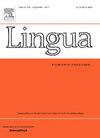二语汉语词汇、语义和形态的共同发展:一个复杂的网络研究方法
IF 1.3
3区 文学
0 LANGUAGE & LINGUISTICS
引用次数: 0
摘要
本研究采用复杂网络研究方法,探讨了第二语言汉语学习者词汇语义知识和形态意识的共同发展。通过跟踪特定的网络指标,如词汇语义网络中密度(ND)的稳步下降以及加权平均程度(WAD)的非单调变化,以及构词法网络中平均程度(AD)的持续上升,我们展示了学习者如何从以广度为重点的词汇增长向更深层次的语义整合转变,同时他们的特征显示出增强的复合生产力和内聚形态连接。这两种能力之间存在很强的相关性,关键特征是网络之间的关键联系。虽然二语汉语学习者的词汇语义知识和词形意识是随着熟练程度的提高而共同发展的,但它们与汉语母语者仍然存在差异。这些发现强调了综合的、有针对性的、有阶段的教学策略对于促进学习者词汇能力发展的必要性。本研究还通过对二语发展的定量和可视化分析,为对外汉语教学提供了实用的见解。本文章由计算机程序翻译,如有差异,请以英文原文为准。
Lexical-semantic and morphological co-development in L2 Chinese: a complex network approach
Using a complex network approach, this study explores the co-development of lexical-semantic knowledge and morphological awareness in second language (L2) Chinese learners. By tracking specific network metrics—such as the steady decline in density (ND) alongside non-monotonic shifts in weighted average degree (WAD) in the lexical-semantic networks, and the persistent rise in average degree (AD) in the word-formation networks—across three proficiency levels, we show how learners move from breadth-focused vocabulary growth toward deeper semantic integration, while their characters show enhanced compounding productivity and cohesive morphological linking. A strong correlation between these two competences is observed, with pivotal characters serving as critical links between the networks. While lexical-semantic knowledge and morphological awareness in L2 Chinese learners co-develop with increasing proficiency, they remain distinct from those of native Chinese speakers. These findings underscore the necessity of integrated, targeted, and stage-specific instructional strategies to facilitate the development of learners’ lexical competence. The study also provides practical insights for teaching Chinese as a foreign language (TCFL) through quantitative and visual analyses of L2 development.
求助全文
通过发布文献求助,成功后即可免费获取论文全文。
去求助
来源期刊

Lingua
Multiple-
CiteScore
2.50
自引率
9.10%
发文量
93
审稿时长
24 weeks
期刊介绍:
Lingua publishes papers of any length, if justified, as well as review articles surveying developments in the various fields of linguistics, and occasional discussions. A considerable number of pages in each issue are devoted to critical book reviews. Lingua also publishes Lingua Franca articles consisting of provocative exchanges expressing strong opinions on central topics in linguistics; The Decade In articles which are educational articles offering the nonspecialist linguist an overview of a given area of study; and Taking up the Gauntlet special issues composed of a set number of papers examining one set of data and exploring whose theory offers the most insight with a minimal set of assumptions and a maximum of arguments.
 求助内容:
求助内容: 应助结果提醒方式:
应助结果提醒方式:


